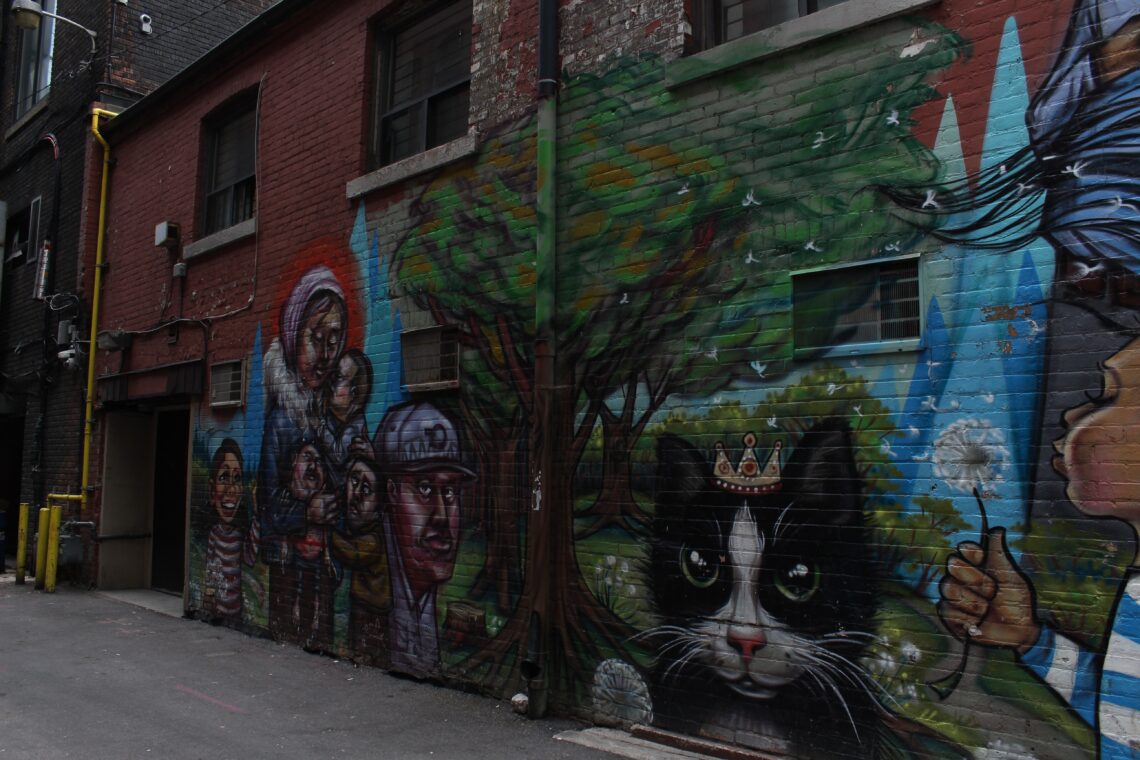
More than just a pretty painting
“People don’t value mental health the same way they value roads and bridges,” says Nick Sweetman, whose towering murals grace the streets of Toronto.
In a conversation about the utility of art and how his work has affected communities, Sweetman acknowledges the simple importance of connecting with people—some of whom may be in dire need of connection—in ways that can’t otherwise be expressed. “I got into art to have conversations with people,” he says.
A city like Toronto is no stranger to street art, from the unburdened explosivity of graffiti to grander masterpieces that people slow down for and everything in between. Like many others, Sweetman’s work does more than beautify sullen walls. “A drive of mine is to talk about environmental and social issues and to use my platform to put the spotlight on other important things,” Sweetman says.
How art speaks and what’s being said
Sweetman has worked with the Youth Climate Collective, an initiative started by Lakeshore Arts to generate awareness about environmental issues as well as to engage young people in expressing their voices about environmental justice through art and creative expression.
A project of this undertaking has proven to be overwhelming for Sweetman, who worries that artwork carrying messages of social importance may do more harm than good by pushing people away who don’t want to see the grim reality of the world presented in artwork. “What is the line that you can push being an artist, as an activist too?” he says.
A similar notion is held by another mural artist in Toronto, who goes by Shalak Attack.
“Art existed from the beginning of humanity. Art has always been hand-in-hand—an intrinsic human necessity,” she says. “We speak with language; art is a visual language, a different kind of expression. Somebody might want to paint more than speak.”
Shalak Attack credits her drive for creative expression stemming from her home environment and family, particularly her mother who allowed a space that nurtured creativity.
“She would let us be free with our expression at home,” she says.
A culture of giving back to the community was essential in her family, prompting her to work in food banks and volunteer even before entering her career as an artist.
Community and ambition
Shalak Attack’s work has also inspired community involvement and empowered people through creative expression. She has organized art workshops for years that involve at-risk youth, prison populations and women empowerment groups, and Shalak Attack recalls her experience organizing a similar program in Montreal 15 years ago. Today, she’s still in touch with the people who participated, who were just children at the time.
In 2014, Shalak Attack organized a muralism workshop in The Esplanade, Toronto and one particular participant went on to assist her in a recent mural she finished at a community engagement project at Wilson Station.
Shalak Attack uses these experiences to comment on the gradual nature of her influence in society. “Sometimes, it’s hard to gauge your impact on a community until later,” she says.
She notes that her career as a muralist was not driven by her desire to earn money but rather her passion for art. “I never got into art myself with the ambition of being a rich person,” she says.
She believes art should be viewed as a means of expression that spoken or written words may not manage to convey, precisely because of the interpretive nature of artwork. “There is no right or wrong way with art.”
Sweetman’s vision of how art can be practically relevant also includes a degree of interpretation as there are many different ways to view art. He also points out the relevance of art as a tool for mental health rehabilitation. “Mental health is really kind of like the backbone of everything, and I think art has a big role to play in mental health in an urban centre,” he says.
He says that even a singular connection with an individual formed through art is a noteworthy impact. The teetering line between artistry and activism has often pushed him to see unexpected reactions.
The importance of backlash
When speaking of a mural he worked on of Breonna Taylor (a Black ER technician who was fatally shot by police in her own home) and Emmett Till (a Black teenager who was brutally lynched in 1955 with no consequences to his murderers), Sweetman says, “We expected kind of a backlash from that because it’s really hard to put something that makes people think about difficult things in their neighborhood.”
He is no stranger to such backlash, citing incidents where his work was painted over and censored because of the messages it carried or when other messages were simply not allowed at all.
A mural project paying tribute to Khaleel Seivwright, a carpenter who was stopped from building shelters for Toronto’s homeless population and Jayme Carter, a victim of unwarranted police brutality, was never given the green light because of the very topic of discussion. “We were not allowed to do that design,” Sweetman says.
Regardless of censorship, artwork cannot draw attention of that degree unless it speaks, as these artists reaffirm. Shalak Attack and Sweetman both say they believe in the vitality of having personal conversations with observers who see their work and the connections they forge through a visual language beyond that which is spoken.
About the author
Aneesh is a former staff reporter for Youth Mind.





